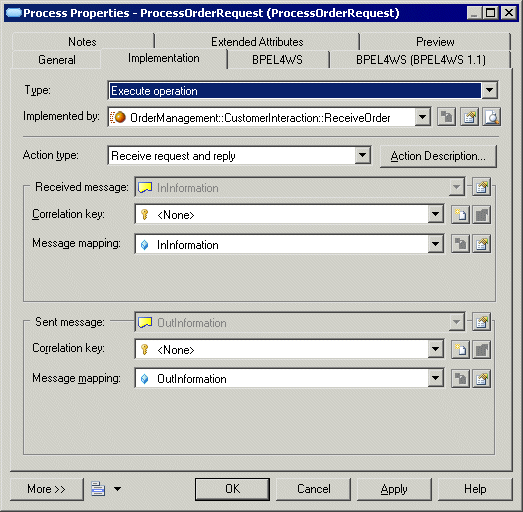Business process diagrams for SOA and other executable languages contain additional objects that allow you to model the implementation of processes through Web services modeled as service providers.
A business process diagram can be created in a model, a package, or within a decomposed process.
|
Object |
Tool |
Symbol |
Description |
|---|---|---|---|
|
Process |

|
 |
Task to perform (see Processes (BPM)). |
|
Organization unit |

|
 |
Organization, service or person that is responsible for a process (see Organization Units ( BPM)). |
|
Flow |

|
 |
Path of the control flow between processes (see Flows (BPM )). |
|
Decision |

|
 |
Decision to take when several flow paths are possible. Only one path will be triggered at execution time (see Decisions (BPM )). |
|
Synchronization |

|
 |
Enables synchronization of flows between two or more concurrent actions or allows the design of a split (see Synchronizations (BPM )). |
|
Start |

|
 |
Starting point of the processes described in the choreography diagram (see Starts and Ends (BPM )). |
|
End |

|
 |
Termination point of the processes described in the choreography diagram (see Starts and Ends (BPM )). |
|
Message format |
None |
 |
Format definition of data exchanged between processes (see Message Formats (BPM)). |
|
Message part |
None |
None |
Portion of the WSDL (Web Services Description Language) message (see Message Parts (BPM)). |
|
Events |
None |
None |
Instantaneous and observable occurrence during the course of a business process (see Events (BPM)). |
|
Service provider |
None |
None |
Web service containing interfaces and operations to implement your processes (see Service Providers (BPM)). |
|
XSD document |
None |
None |
Contains the data schema handled by a service provider (see XSD Documents (BPM)). |
|
Variable |
None |
None |
Data container (see Variables (BPM)). |
|
Correlation key |
None |
None |
Set of variables used to identify a process instance (see Correlation Keys (BPM)). |
|
Data transformation |
None |
None |
Object that allows the copy of data from a source to a target with potential transformations (see Data Transformations (BPM)). |
- Import a WSDL file to obtain the Web services that will implement your processes as service providers (see Importing a Service Provider from a WSDL File).
- Define service provider operations to implement your processes (see Linking an Operation to a Process).
- Model breaks in the normal flow of processes using events (see Events (BPM)), catch events using event handlers (see Event Handlers) or generate events from processes (see Process Properties).
- Perform transformations on data (see Implementing Processes).
- Specify input and output messages on processes to specify data exchange between
partners (see Linking an Operation to a Process). In the
following example, the ProcessOrderRequest process is implemented by a
ReceiveOrder operation, which receives an Ininformation message
from a partner and replies with an Outinformation
message:Note: No data is specified on flows between processes when modeling with execution languages.
